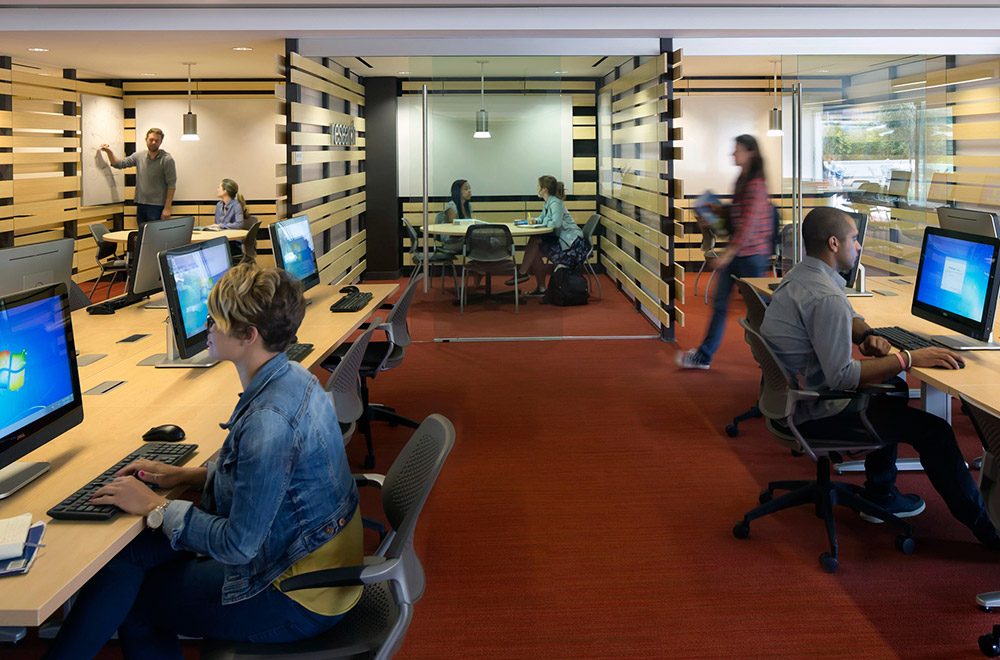Welcome to HMC Architects’ Five in Focus blog series, where we explore the latest trends, ideas, and innovations shaping the future of architecture and design. This series asks our design professionals to tell us what’s capturing their attention and offer some insights.
Sean Rosebrugh, AIA, LEED BD+C, is HMC’s higher education market leader. He shares some thoughts from attending the ACUHO-I conference this past summer. They include understanding your audience, addressing declining enrollment, the elusive nature of Public-Private Partnerships (P3s), assessing institutional perception, and the impact of the Sturdy Act on Student Housing budgets.
1. Know Your Audience
Well, we tried. Our recent out-of-state conference experience taught us that knowing our audience is paramount. We initially set up a Yahtzee game to engage conference-goers and give away Starbucks and Bevmo gift cards. However, we soon discovered that Bevmo is mainly relevant to California, Arizona, and Washington residents, which excluded a significant portion of our audience. We changed our prize strategy to adapt and peeked at the institutions on name tags. In hindsight, we realized the importance of adjusting on the fly and incorporating creative strategies for future events. Next time, we’ll enhance our booth with better lighting, QR codes on brochures, and bold text on our banners and tablecloths. Adaptation is the key, and we look forward to seeing you in Anaheim in 2024!
2. Declining Enrollment
Higher education in the U.S. is on the cusp of a demographic cliff set to begin in 2025, with an 11 percent drop in 18-year-olds. This could lead to a 25 percent decline in applications, affecting mid-sized state institutions and midwestern regions the most. Traditional strategies like targeting international students and adding athletics or out-of-state students create intense competition for a dwindling pool. New approaches emphasize creating engaging spaces in housing, such as maker spaces, academic and social support services, 3D printers, gaming rooms, and living/learning centers, and fostering connections with local businesses for internships. More flexibility in student mobility within the housing system can help them discover their life’s path.
3. P3 Challenges
In Public-Private Partnerships (P3s), “more is said than done” holds true. Concerning P3s, the gap between intent and execution is a formidable challenge. The realities of high interest rates and labyrinthine negotiations can overshadow the allure of these partnerships. Institutions must meticulously strategize, not only to navigate the complexities but also to assess the actual practicality and feasibility of P3s. A judicious approach ensures that these collaborations don’t become mere talking points lost in the din of higher education’s ever-changing landscape. Institutions need to strike a balance between ambition and pragmatic execution when exploring P3 opportunities.
4. Assessing Institutional Perception
Institutions can indeed assess their perception. Through their Investor in Students group, WAU Agency shared a fascinating 360-degree process at a sparsely attended session. Their method combines online surveys, institutional data, stakeholder interviews, and comments to quantify institutional performance and perception. More importantly, they provide actionable items for institutions to implement and tools to track progress. This approach can be a valuable resource for institutions looking to improve their image.
5. The Sturdy Act and Student Housing FFE Budgets
In light of the Consumer Product Safety Commission’s new regulations, higher education institutions may face an unexpected challenge in their student housing development projects. The Sturdy Act, designed with the safety of small children in mind, has cast a wide net, affecting the furniture used in college dormitories. Those planning student housing must now account for the added costs of ensuring that dressers and storage furniture meet the newly imposed safety standards. While the safety of students is paramount, the financial implications of these design changes must be addressed. Student Housing FFE (furniture, fixtures, and equipment) budgets may need to be adjusted to accommodate the increased production and shipping costs incurred due to the necessity of anchoring and weighting furniture pieces. This shift in design requirements serves as a reminder that architects and higher education institutions must remain vigilant in monitoring and adapting to evolving regulations to ensure the safety and well-being of students while still managing their budgets effectively.
